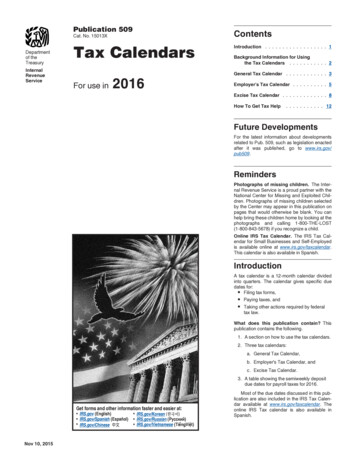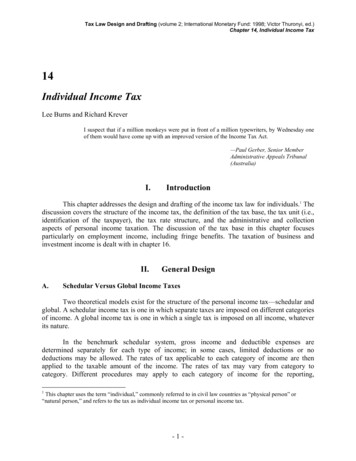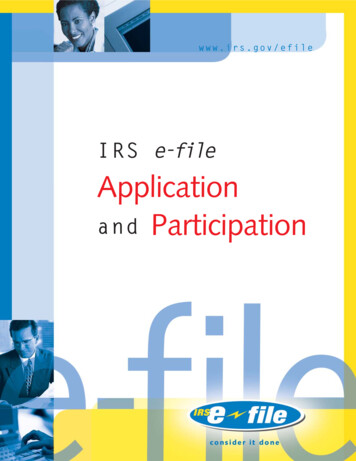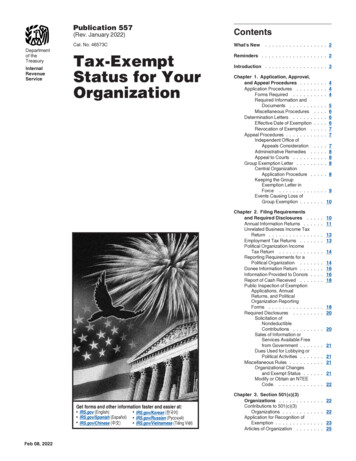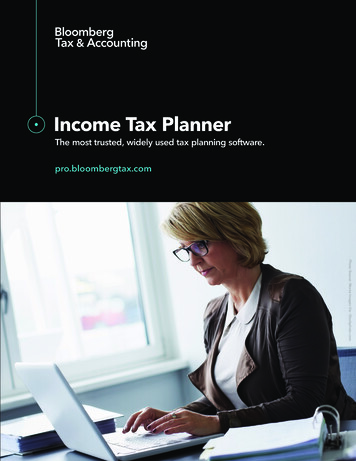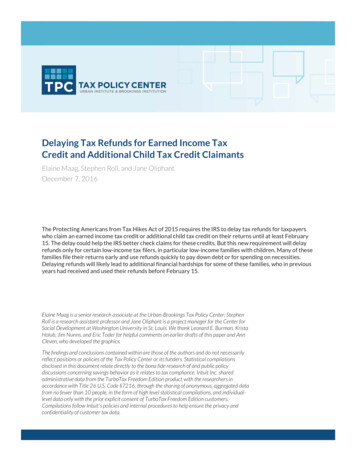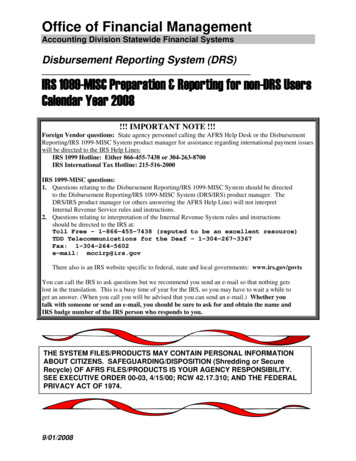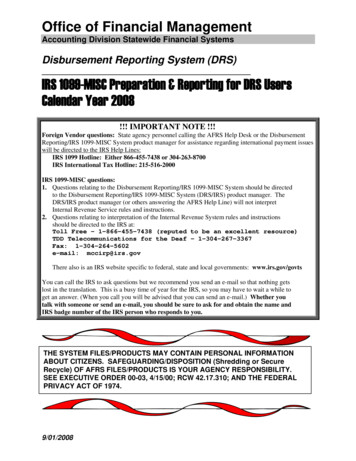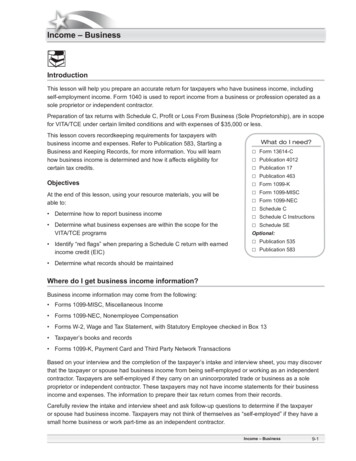
Transcription
Income – BusinessIntroductionThis lesson will help you prepare an accurate return for taxpayers who have business income, includingself-employment income. Form 1040 is used to report income from a business or profession operated as asole proprietor or independent contractor.Preparation of tax returns with Schedule C, Profit or Loss From Business (Sole Proprietorship), are in scopefor VITA/TCE under certain limited conditions and with expenses of 35,000 or less.This lesson covers recordkeeping requirements for taxpayers withbusiness income and expenses. Refer to Publication 583, Starting aBusiness and Keeping Records, for more information. You will learnhow business income is determined and how it affects eligibility forcertain tax credits.ObjectivesAt the end of this lesson, using your resource materials, you will beable to: Determine how to report business income Determine what business expenses are within the scope for theVITA/TCE programs Identify “red flags” when preparing a Schedule C return with earnedincome credit (EIC)What do I need? Form 13614-CPublication 4012Publication 17Publication 463Form 1099-KForm 1099-MISCForm 1099-NECSchedule CSchedule C InstructionsSchedule SEOptional: Publication 535Publication 583 Determine what records should be maintainedWhere do I get business income information?Business income information may come from the following: Forms 1099-MISC, Miscellaneous Income Forms 1099-NEC, Nonemployee Compensation Forms W-2, Wage and Tax Statement, with Statutory Employee checked in Box 13 Taxpayer’s books and records Forms 1099-K, Payment Card and Third Party Network TransactionsBased on your interview and the completion of the taxpayer’s intake and interview sheet, you may discoverthat the taxpayer or spouse had business income from being self-employed or working as an independentcontractor. Taxpayers are self-employed if they carry on an unincorporated trade or business as a soleproprietor or independent contractor. These taxpayers may not have income statements for their businessincome and expenses. The information to prepare their tax return comes from their records.Carefully review the intake and interview sheet and ask follow-up questions to determine if the taxpayeror spouse had business income. Taxpayers may not think of themselves as “self-employed” if they have asmall home business or work part-time as an independent contractor.Income – Business9-1
Taxpayers who transact in or trade any virtual currency should be referred to a professional tax preparer. Identifythese situations as early in the interview as possible.Income received from all sources in a self-employed taxpayer’s business must be reported, unless excludedby law.The Families First Coronavirus Response Act creates two new credits: Credit for sick leave for certain self-employed individuals Credit for family leave for certain self-employed individualsSee Publication 4491, Payments and Miscellaneous Refundable Credits lesson, and the Volunteer Resource Guide,Tab H, Other Taxes, Payments and Refundable Credits, for details.Cash IncomeSome taxpayers may indicate that they received cash income for self-employment activity. This incomemust be reported, unless excluded by law.If taxpayers do not have adequate records of the cash income they received, you may be able to assistthem with simple record reconstruction. See the section on reconstructing records later in this lesson.Form 1099-NEC, Nonemployee CompensationTaxpayers who are independent contractors should receive Form 1099-NEC showing the income theyearned from payers who are required to file Forms 1099. The use of Form 1099-NEC to report paymentsto independent contractors is new for 2020. The amount from Form(s) 1099-NEC, along with any otherbusiness income payments, are reported on their tax return.A taxpayer does not have to conduct regular full-time business activities to be self-employed. Having apart-time business in addition to a regular job or business may be self-employment. Ask for any Form(s)1099-NEC that document this income. Subcontractors or individuals (including for-hire drivers) whoreceive less than 600 may not receive Form 1099-NEC, but still must report all their income. Also askfor documentation of any business income that was not reported on Form W-2 or Form 1099-NEC (e.g.,payments received from individual clients who do not need to file Form 1099).exampleTim works as an independent contractor for ABC Construction Company. The company sent Tim aForm 1099-NEC that shows he received 15,000 for the work he did for them. He also received cashpayments of 4,000 from several different individuals for the work he completed. He did not receiveForms 1099-NEC for the 4,000. Tim must include the 4,000 cash payments as self-employmentincome along with the 15,000 from Form 1099-NEC.Form 1099-MISC, Miscellaneous IncomeTaxpayers may receive other business income on Form 1099-MISC, Boxes 2 and 3. Refer to Schedule Cinstructions for more information.Form 1099-K, Payment Card and Third Party Network TransactionsForm 1099-K is used by third-party networks (such as Visa, Mastercard, or others) to report transactionsprocessed for taxpayers, including those who use their automobiles for hire or ride share services such asUber, Lyft, Sidecar, etc. Taxpayers may not receive the Form 1099-K if the amount is less than 600, but theamount received must still be reported.9-2Income – Business
exampleDarryl used his car only for personal purposes during the first 6 months of the year. During the last 6months of the year, he drove the car a total of 18,000 miles. Of those miles, 15,000 miles were drivenproviding transportation through a ride-sharing service. He received a Form 1099-K showing the incomehe received from the ride-sharing business. Darryl can deduct the 15,000 miles using the standardmileage rate as well as any other ordinary and necessary business expenses, such as supplies, acell phone, food and drinks for passengers, parking fees, tolls, roadside assistance plans, businessinsurance, and taxes.Qualified Medicaid Waiver PaymentsQualified Medicaid waiver payments may be excluded from gross income. To be qualified Medicaidwaiver payments, the care provider and the care recipient must reside in the same home. When the careprovider and the care recipient do not live together in the same home, the Medicaid waiver payments arefully taxable.A taxpayer may choose to include qualified Medicaid waiver payments in the calculation of earned incomefor the EIC and the ACTC. The taxpayer may include qualified Medicaid waiver payments in earned incomeeven if the taxpayer chooses to exclude those payments from gross income. A taxpayer may not choose to include or exclude only a portion of qualified Medicaid waiver payments.Either include all or none of the qualified Medicaid waiver payments for the taxable year in earnedincome. If the taxpayer chooses to include qualified Medicaid waiver payments in earned income, that amountwill be included in the calculation for both the EIC and the ACTC.Refer the Volunteer Resource Guide, Tab D, Income, Entering the Medicaid Waiver Payments.How is business income reported?Form 1040, Schedule CForm 1040, Schedule C, is used to report income from a business operated or a profession practiced as asole proprietor. Schedule C shows the income and expenses and the net income amount is carried to Form1040. An activity qualifies as a business if the primary purpose for engaging in the activity is for incomeor profit and the taxpayer is involved in the activity with continuity and regularity. For example, a sporadicactivity or a hobby does not qualify as a business. A hobby is an activity typically undertaken for pleasureduring leisure time.To report income from an activity not for profit, see the instructions for Form 1040 and Publication 17, OtherIncome. This topic is out of scope. Refer any taxpayers with not-for-profit activity to a professional taxpreparer.Form 1040, Schedule C, is also used to report wages and expenses the taxpayer had as a statutoryemployee or certain income shown on Form 1099-MISC or Form 1099-NEC.Some employers misclassify workers as independent contractors and report their earnings onForm 1099-MISC or Form 1099-NEC. Taxpayers who believe they have been misclassified should contact the IRSand ask for help.Volunteer tax preparers who have Advanced certification can assist with preparation of the limited Schedule C.Income – Business9-3
Tax Software Hint: The tax software calculates net profit after income and expense entries are made.Next, the software transfers the net profit to the applicable line on Schedule SE, Self-Employment Tax, tocompute the self-employment tax. Amounts are then transferred to the applicable lines of Form 1040.The following terms are used in the preparation of business returns:Definition of TermsBusiness expensesBusiness expenses are amounts that are ordinary and necessary to carry onthe business.Cash methodof accountingThe cash method of accounting reports all income when received and deductsall expenses when paid.InventoryInventory is the items the taxpayer buys or makes for resale to others.Taxpayers with inventories should be referred to a professional tax preparer.DepreciationThe cost of items that are expected to last more than a year should be spreadover a period of years rather than deducted in the year of purchase. If thetaxpayers have such a cost, they should be referred to a professional taxpreparer.Election to expensebusiness assetsAn election is available to immediately expense qualifying business assets.Taxpayers who wish to expense business assets should be referred to aprofessional tax preparer.What is in scope for VITA/TCE?Volunteers can assist taxpayers who have returns that require Schedule C with certain limits: Have less than 35,000 in business expenses Use the cash method of accounting Have no inventory at any time during the year Did not have a net loss from the business Have no employees during the year and did not pay contract labor for services (out of scope issue) Are not required to file Form 4562, Depreciation and Amortization, for this business (depreciation and theelection to expense business assets are out of scope for the VITA/TCE programs) Do not deduct expenses for business use of a homeDuring the interview, if you discover taxpayers have issues that fall outside the scope of the VITA/TCEprograms, refer them to a professional tax preparer.More than one Schedule C can be prepared if the taxpayers have more than one business.The net profit or loss will be reported on Form 1040. The net profit will also need to be shown on Schedule SEin order to calculate the self-employment tax. Schedule SE will be covered in a later lesson.Taxpayer Interview and Tax Law ApplicationAs you review the intake and interview sheet with taxpayers, ask questions to determine if they have anyself-employment income, their accounting method, and their business expenses, as shown in this sampleinterview:9-4Income – Business
SAMPLE INTERVIEW.VOLUNTEER SAYS JASON RESPONDS What kind of business do you have and were youthe sole owner?I install air conditioners and, yes, I own the businessmyself. No partners or employees.Do you have a record of your business income and Yeah, I’ve got a separate checking account for myexpenses for last year?business. I had a pretty decent first year actually.Do you use the cash method of accounting?Yes. I have a printout of my year-end summary here.And what were your expenses?Well, I do the installations myself; I spend a lot ofmoney on parts, tools that last less than a year, andequipment repairs. My expenses for the year were 2,212.Do you keep any parts in inventory?No, I purchase the parts when an order is placedwith me.And you say you had a good year? In other words,did you make a profit?That’s correct.Do you plan on deducting expenses for thebusiness use of your home?No, I don’t.Okay, and how much business income did you have?My gross totaled 30,762.[On page 2 of the intake and interview sheet, indicateJason’s responses to these questions.]EXERCISEQuestion 1: Based on the information in the sample interview, is Jason’s return in scope for VITA/TCE? Yes NoHow do you clarify tax payers’ business income and expenses?All IRS-certified volunteers must exercise due diligence when preparing tax returns. Due diligence meansdoing your part to ensure tax returns are correct.This means, as a volunteer, you must do your part when preparing or reviewing a tax return to ensure theinformation on the return is correct and complete. Generally, you can rely in good faith on information from ataxpayer without requiring documentation as verification.However, when preparing a tax return with a Schedule C and the earned income credit (EIC), takeadditional steps to determine that the net self-employment income used to calculate the amount of,or eligibility for, EIC is correct and complete. Additional clarification or inquiries should be made if theinformation furnished by the taxpayer appears to be incorrect, incomplete, or inconsistent. Taxpayerssometimes want to over report or under report their income to qualify for or maximize the amount of EIC.Ask sufficient questions of taxpayers claiming self-employment income to be satisfied that: The taxpayer actually conducts a business The taxpayer has records to support income and expenses, or can reasonably reconstruct income andexpense records All income and related expenses have been included on the taxpayer’s Schedule CIncome – Business9-5
Emphasize to taxpayers that in the event of an IRS audit, they would need to provide receipts to supporttheir reported income and expenses.What Schedule C situations raise a “red flag”?As a volunteer preparing a tax return with Schedule C, watch for examples of incorrect, incomplete, orinconsistent information, such as: Schedule C income reported in round numbers Schedule C cash businesses as the only source of income on a return claiming EIC Schedule C with little or no expenses when expenses would be expected Schedule C taxpayers with little or no records for income and expenses Any Schedule C income that qualifies the taxpayer for the maximum EIC Schedule C without a Form 1099Taxpayer Interview and Tax Law ApplicationA taxpayer, Dana, comes in to have her tax return prepared. She tells you she runs her own babysittingbusiness and wants to claim the EIC.To assist the taxpayer in completing an accurate return, you need to ask more questions to determine ifDana did incur allowable business expenses and that the income she reported is correct.SAMPLE INTERVIEW.VOLUNTEER SAYS DANA RESPONDS Tell me about your business, and were you the soleowner?I have a babysitting service that I handle all bymyself.Do you have a record of your business income andexpenses for last year?Well, I’m not very good at keeping records,but I can tell you that I made 14,000 over thecourse of the year. I didn’t have any expenses.How did you determine that you made a net profit of 14,000?I based my income on deposits to mychecking account.I see. We may be able to reconstruct your businessincome based on your deposits. Did you bring any bankstatements or your checkbook record with you today?No, I’m sorry.How many children did you care for, and was this a fulltime or part-time job for you?Babysitting is just part-time. I watch several ofmy neighbors’ children along with my own kidswho are 8 and 10 years old.What is your fee for babysitting?It averages about 10 an hour.Do you have a calendar or schedule of the childrenpresent each day?No, but I may be able to come up with one.Do you have a business license or permit, and do youwatch the children in your own home or in a daycarefacility or in the client’s home?My home and sometimes at my neighbors’homes. I don’t need a permit.Do you buy any supplies such as food, diapers, toys,or other items necessary for the business?Sometimes I need to buy supplies. But I didn’tbring receipts with me.Did you intend to deduct expenses for the businessuse of your home?No, I don’t think so.9-6Income – Business
SAMPLE INTERVIEW.VOLUNTEER SAYS DANA RESPONDS Be aware that the IRS requires that you report allincome and allowable expenses on your tax return.In the event of an IRS audit, you will be responsible forproviding support for the income and expenses claimedon your return. Before we can proceed, you’ll needto gather some additional facts and records. I’ll writedown a list of items that could help us more accuratelycalculate your net profit from your business.OK – thanks. I’ll see what I can pull together.The information provided by the taxpayer appears to be both inconsistent and incomplete, because it isunlikely that someone who operates this type of business:1. Has no business expenses. Most businesses have expenses, even if it is just a few dollars here andthere.2. Has annual gross receipts from the business that are an exact round dollar amount, and that amountmaximizes EIC.The volunteer cannot complete a return based on information provided, but gives Dana the chance togather materials to document her business.What business expenses are within scope for the VITA/TCE programs?Taxpayers deduct the costs of running their business. These costs are known as business expenses.To be deductible, a business expense must be both ordinary and necessary. An ordinary expense is onethat is common and accepted in the taxpayer’s industry. A necessary expense is one that is helpful andappropriate for the taxpayer’s trade or business. All ordinary and necessary expenses incurred in a selfemployed taxpayer’s business must be reported. See the Instructions for Schedule C for more detailedinformation on deductible business expenses. Examples of these expenses include the following:AdvertisingAdvertising expenses are the costs associated with promoting the business through various meansincluding internet ads, newspapers, magazines, billboards, racing sponsors, and television spots.Every self-employed taxpayer must claim all allowable deductions in computing net earnings fromself-employment.Car and Truck ExpensesA taxpayer who uses a car or truck in a business may be able to deduct the costs of operating andmaintaining the vehicle. This is true even if the taxpayer used the vehicle for hire. Vehicle expenses canbe calculated using actual expenses or the standard mileage rate. Actual expenses include depreciation.The calculation of depreciation is outside the scope of the VITA/TCE programs. If the taxpayers have usedactual expenses in the past, or wish to use actual expenses in the current year, they must be referred to aprofessional tax preparer.For the standard mileage deduction, the current standard mileage rate is multiplied by the number ofbusiness miles. Self-employed taxpayers can also deduct the business part of interest on a car loan, stateand local personal property tax on the car, parking fees, and tolls, whether or not they claim the standardIncome – Business9-7
mileage rate. For-hire drivers may have other deductible car expenses such as cellular service, fees, andride-sharing insurance in addition to using the standard mileage rate. Commuting and other personalautomobile expenses such as depreciation, lease payments, maintenance and repairs, gasoline (includinggasoline taxes), oil, insurance, or vehicle registration fees are not deductible.exampleWendy is a self-employed masseuse and does not maintain an office in her home. She does neckmassages for office workers and travels to three office buildings each work day. It is 10 miles from hometo the first office and 5 miles from the last office back home. These 15 miles are commuting miles and,therefore, not deductible. The 13 miles Wendy drives from the first office to the second office and 5 milesfrom the second office to the third office are deductible. Of the 33 miles driven each work day, 18 milesare deductible.Commissions and FeesCommissions or fees are paid to both individuals and businesses. If payments to a single individual are 600 or more, the taxpayer must report the payments on Form 1099-MISC or Form 1099-NEC. In this case,the taxpayer’s return is out of scope for the VITA/TCE programs.InsuranceInsurance policies and coverage are deductible for the business operation. This includes property andbusiness liability insurance.If the standard mileage rate is used, no deduction is allowed for regular automobile insurance premiums.A for-hire driver’s cost of extra liability coverage can be added to the standard mileage rate if separate fromthe main policy.Health insurance for the sole proprietor and his or her family is not deductible as a business expense onSchedule C. However, these medical premiums may be deducted on Form 1040 as an adjustment to grossincome, subject to qualifications.Other InterestThis category can include interest paid on business operating loans, but not mortgage interest. Businessinterest includes the business portion of interest on a car loan – it can be added to the standard mileagerate.Legal and Professional ServicesExpenses included on this line are fees paid to professionals, such as attorneys, accountants, appraisers,and engineers.Legal fees paid to acquire business assets are not deductible. These costs are added to the basis of theproperty. Some accountant fees and attorney fees may be for personal services (e.g., tax returns, wills, orestates) and are not deductible as business expenses.Payments over 600 may require a Form 1099-MISC or 1099-NEC to be completed, which makes thereturn out of scope.Office ExpenseOffice expense generally includes supplies such as pens, paper, and postage.Rent or Lease – Vehicle, Machinery, and EquipmentThis category includes rental fees for cars, trucks, vans, machinery, equipment, and other personalproperty. Vehicle leases of more than 30 days are out of scope. If the taxpayer uses the standard mileagerate method for business miles of a leased vehicle, the return remains in scope.9-8Income – Business
Repairs and MaintenanceRepairs on equipment, office space, and buildings are some possible expenditures reflected in thiscategory. Expenses that should not be reflected are: Capital equipment that is improperly expensed (see Cost Recovery in Publication 535, BusinessExpenses). Repairs that substantially improve a facility or equipment that should be capitalized.Also see the de minimis expense election below under Other Expenses.SuppliesSupplies expense includes costs for general operating supplies not associated with the cost of goods sold.Taxes and LicensesTaxpayers can deduct taxes and license fees paid in the operation of their business. Examples include: State and local sales taxes imposed on the taxpayer as the seller of goods or services Real estate and personal property taxes on business assets Certain licenses and regulatory feesTravel and MealsTravel expenses are the ordinary and necessary expenses of traveling away from home for business.Examples of deductible travel and meal expenses are in the Volunteer Resource Guide, Income tab.UtilitiesUtilities typically consist of normal electric, gas, water, and telephone expenses for the business. The baserate of the first telephone land line to a residence cannot be deducted, but additional costs incurred forbusiness purposes can be included as an expense. There should be no deduction for personal expenses orexpenses for a home office in this category.exampleKiana runs a small business from her home. She has only one phone line and frequently makes longdistance calls for business. The cost of the phone line cannot be deducted, but Kiana can deduct thelong-distance charges for her business calls.Other ExpensesTaxpayers may also be able to deduct other ordinary and necessary business expenses not deductedelsewhere on Schedule C. Taxpayers can deduct the cost of their education expenses (including certainrelated travel) related to the trade or business. Taxpayers must be able to show the education maintainsor improves skills required in their trade or business, or that it is required by law or regulations, for keepinglicense to practice, status, or job. See Form Schedule C Instructions (Part V – Other Expenses) andPublication 535 for more information.Taxpayers may elect to apply a de minimis safe harbor to amounts paid to acquire or produce tangibleproperty used in the taxpayer’s trade or business. They may use this safe harbor to deduct amounts paidfor tangible property up to 2,500 per invoice or item (substantiated by invoice) if they have accountingprocedures in place whereby they deduct amounts paid for business property if the costs of such propertyare under a certain de minimis amount. The de minimis safe harbor election does not include amounts paidfor inventory and land. The election applies for the taxable year and, if made, applies to each expendituremeeting the criteria for the election in the taxable year. Make the election by attaching a statement titled“Section 1.263(a)-1(f) de minimis safe harbor election” to a timely filed original federal tax return includingextensions for the taxable year in which the de minimis amounts are paid. The statement should include theIncome – Business9-9
taxpayer’s name, address, and Taxpayer Identification Number, as well as a statement that the taxpayer ismaking the de minimis safe harbor election.exampleBarry makes his living as a handyman and earned 17,438 during the tax year. In the same year, Barrybought a new ladder for 450 and uses it exclusively in his business. In keeping his books and records,Barry uses an accounting procedure whereby he deducts amounts he pays for business equipment if thecost of the equipment is 1,000 or less. Under the de minimis safe harbor, Barry can deduct the full costof the ladder as a business expense, as well as any other equipment purchases for 1,000 or less, byattaching the required statement to his timely filed tax return.For-hire drivers who have mileage in between customer pick-ups can claim the mileage as a businessexpense.How do I complete Schedule C?On Schedule C, business expenses are broken down by category.General Information SectionUsing the Volunteer Resource Guide, Tab D, Income, complete lines A-J. Pay special attention to theseitems: Check accounting method. (Only cash method is in scope for the VITA/TCE programs; if taxpayers useanother method, refer them to a professional tax preparer.) Check the “Yes” or “No” box for: Did the taxpayer “materially participate” in the operation of the business?– In general, the taxpayer materially participates if based on all the facts and circumstances, thetaxpayer participated in the activity on a regular, continuous, and substantial basis during the year.See the Schedule C Instructions for specific tests to determine if the taxpayer meets the requirementsfor material participation.– If the taxpayer meets one of the tests for material participation, check the “Yes” box, otherwise theanswer is “No.” If there is uncertainty about the taxpayer materially participating in the business, referthem to a professional tax preparer. Check the “Yes” or “No” box for: Did the business make any payments in the tax year that would requirefiling of Form(s) 1099? If Yes, did or will the business file required Forms 1099? Check the “Yes” or “No” box.In general, taxpayers who seek assistance through the VITA/TCE programs may be required to file Form1099-MISC or Form 1099-NEC for payments in the amount of 600 or more for services performed for atrade or business by people not treated as its employees or for rent paid. The taxpayer must file Form 1099MISC or Form 1099-NEC to report contract labor or rent payments. For a complete listing of Forms 1099and the requirements for filing each one, refer to the chart in the General Form 1099 Instructions.If the taxpayer responds Yes to making payments that would require the filing of Form(s) 1099, the incometax return and any related Form 1099 preparation are both out of scope for the VITA/TCE programs. Thetaxpayer must be referred to a professional tax preparer even if the taxpayer indicates they have alreadyfiled the Forms 1099.9-10Income – Business
Part I: IncomeEnter each Form 1099-MISC or 1099-NEC that the taxpayer received. Also enter income that was notreported on a Form. The combined total represents the gross receipts from the taxpayer’s trade orbusiness. Refer to the Volunteer Resource Guide for the software entries, including when the income wasreported on Form W-2 and the “Statutory Employee” box on that form is checked.Determine if the taxpayer received business income that was not reported on Form 1099-MISC. For example,tips received by self-employed hair stylists or manicurists are to be included in gross receipts on Schedule C.Statutory EmployeesA “Statutory employee” can report the income and claim expenses related to that income on Schedule C.Enter the statutory employee income from Form W-2, Box 1, on line 1 of Schedule C. Social Security andMedicare taxes should have been withheld from the earnings; therefore, the taxpayer does not owe selfemployment tax on these earnings. Be sure to indicate that this is a statutory employee on the input screenso that the self-employment tax is not computed by the software. Statutory employees include full-time lifeinsurance agents, certain agent or commission drivers, traveling salespersons, and certain home workers.Self-employment income and statutory employee income cannot be reported on the same Schedule C. Thetaxpayer must file two separate Schedules C.Part II: ExpensesOn Schedule C there is a separate line for the most common expenses that are incurred i
Form 1040, Schedule C Form 1040, Schedule C, is used to report income from a business operated or a profession practiced as a sole proprietor. Schedule C shows the income and expenses and the net income amount is carried to Form 1040. An activity qualifies as a business if the primary purpose for engaging in the activity is for income


